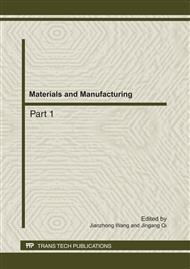p.696
p.700
p.704
p.708
p.712
p.718
p.722
p.727
p.735
Research of SiCP/2A50 Composite Materials Creeper Treads Prepared by Liquid Forging
Abstract:
Microstructure of creeper treads is inhomogeneous when they are produced by way of common casting, which lead to lower mechanical properties. Compound loading and feeding are introduced into the technology of liquid forging. Defects of filling incompletely, shrinkage porosities and cavities are usually appeared in raised part of creeper treads. With feeding amount increased above 5mm, plastic deformation also would be increased, so the microstructure and mechanical properties of raised part were improved and those defects disappeared meanwhile. SiCP/2A50 composite materials were used in order to enhance abrasive resistance and extend their service life. Creeper tread produced by compound loading and feeding could obtain homogeneous and fine microstructure. Average tensile strength and hardness of specimen reached 360MPa and HV115.97 respectively after (500°C×3h) solution treatment, (20min) quenching and (160°C×10h) artificial aging. The results show that inhomogeneous character of microstructure and mechanical properties of creeper treads could be overcome by compound loading and feeding.
Info:
Periodical:
Pages:
712-717
Citation:
Online since:
July 2011
Authors:
Price:
Сopyright:
© 2011 Trans Tech Publications Ltd. All Rights Reserved
Share:
Citation:


